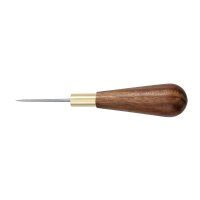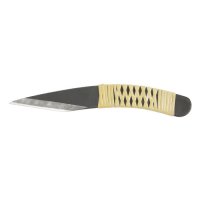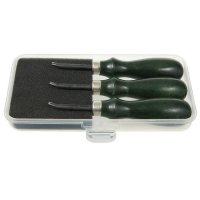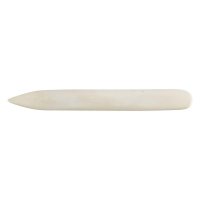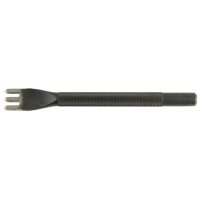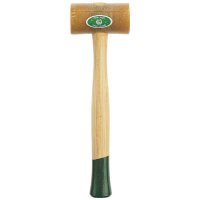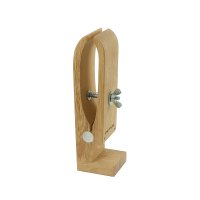
To start working with leather, all you need are a few select tools. Whether you want to make leather sheaths for your knives or tool blades, sew a high-quality belt or bags and cases, you do not need much space for this hobby and the number of tools you need is also kept within limits.
Worktop
Apart from a table to work on, you will need a cutting mat. The green mats with a centimetre grid are ideal for cutting leather with cutters, scalpels, and veneer knives. However, they offer too much resistance when cutting and skiving with a half-moon knife. Due to the printed grid, you do not need an additional angle when cutting leather parts at right angles.
When it comes to working with hole punches or pricking irons, you need a firmer base which spares the cutting edges. A cutting mat is too thin and is easily damaged by the firm blows and punching through the holes. A piece of wood, for example an old chopping board, is sufficient. Kitchen chopping boards made of soft plastic also work well.
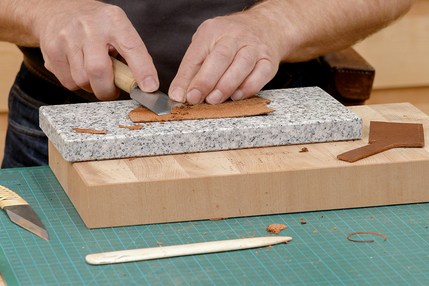
Different jobs need different worksurfaces
When skiving leather edges, a stone plate such as granite plate is helpful as a base. A polished stone plate as a base prevents snagging and cutting into the cutting base during skiving. If you want to punch leather, the stone plate is a practical base, as it absorbs the blows well.
Cutting tools
With a round awl it is easy to mark the cutting lines, seams, and holes. For marking the distance between seam and leather edge or between belt holes, a French spring divider is the tool of choice. The points of the awl and compass must not be too sharp and scratch. They are just meant to press an indentation into the leather surface. Round and polish the tips of the tools if necessary.
When it comes to cutting straight edges, you need a steel rule. If you plan to make belts, a ruler length of at least one metre is recommended.
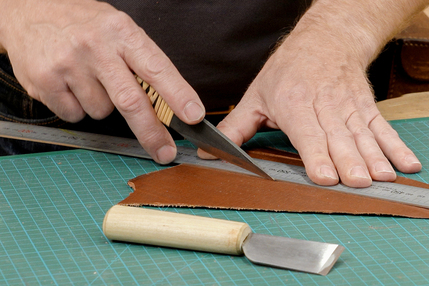
A one-sided bevel makes sense when cutting along a ruler
You can choose from between various knives for cutting. Traditionally, the half-moon knife is used in leather working. However, handling and especially resharpening it requires a lot of experience and practice. Rolling knives are often used, but their blades are very thin and flexible, so that cutting should be done with very little pressure, otherwise the edges will become slanted. Our Japanese leather knife comes highly recommended. It is ground only on the right side and can therefore be guided very precisely along the ruler. Its slim tip enables you to cut smaller radii. If available, a scalpel or cutter knife will also work at the beginning.
Tools and materials for edge processing
After cutting, the leather edges usually need trimming. First, the cut edges on the top and bottom of the leather are chamfered or rounded with an edge beveller. For different leather thicknesses, we recommend the practical edge beveller set with three different radii.
If several layers of leather have been sewn or riveted together, slight offsets of the layers should be removed with sandpaper before rounding the edges. You can also use it to finish and trim the outer curves of the leather piece’s contours.
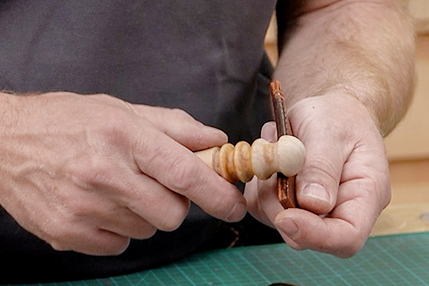
Leather edges are polished with an edge slicker and water
After that, the edges can be polished with an edge slicker and water. Use Tokonole to speed up the polishing process. You can also use it to smooth the rough leather (skin) side where necessary. Use a narrow folding bone to smooth and repolish narrow, less easily accessible areas.
Sewing tools
If you want to sew two or more leather parts together, they are usually fixed with glue first. When using contact adhesive, for example Kövulfix contact adhesive, it is advisable to tap the bond with a hammer. The hammer should have a slightly convex head to prevent visible marks in the leather. A leather hammer with flat edge is perfect for reaching even narrow corners. Japanese carpenters’ hammers with their convex heads can also be used.
The holes for sewing leather are usually pre-pierced. For this purpose, you need leather stitching tools with six cutting edges or three cutting edges.
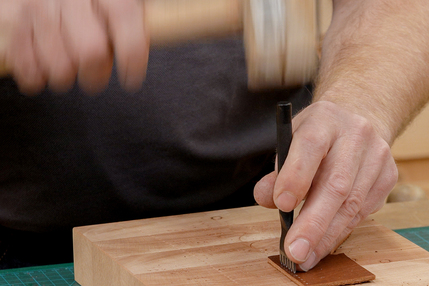
Pricking irons ensure an even seam pattern
You strike these tools with a soft-face or rawhide hammer on a suitable base (see above). You also need a saddler's awl to get through very thick layers of leather and to widen the holes a little when sewing.
A classic saddler's seam is sewn with two needles at a time. The leather parts are held in a stitching pony. When getting started, you can use your own construction or a small vice. Needle and thread and a piece of beeswax complete your basic set of leather sewing tools.
Hole punching tools
If you want to make leather belts or to attach rivets, you need to make holes in the leather. For belts, a good pair of hole punch pliers will do. However, if the holes are located further inside the leather piece, you cannot avoid using hole punches. Since hole punches can be used to reach everywhere and are also very practical for cutting inside curves, a set of hole punches with different diameters is recommended. Hole punches and pricking irons should only be used with a soft-face hammer on a suitable base.
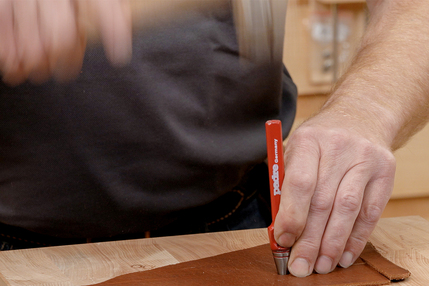
Hole punches are also suitable for cutting inner curves
Tool list
Compared to other craft hobbies, relatively few tools are needed to get started in leather working. Here is our suggestion for an 18-piece tool kit:
- Cutting Pad
- Granite Stone Plate
- Shinwa® Precision Rule, 1000 mm
- DICTUM® Round Awl, 45 mm
- French Spring Dividers, Shaft Length 200 mm
- Japanese Leather Knife
- Edge Bevellers, 3-Piece Set
- Edge Slicker, 4 Widths
- Tokonole Leather Polish
- Folding Bone
- Kövulfix Contact Adhesive
- Vergez Blanchard Leather Hammer, No. 3
- Leather Thonging Chisels, 6 Prongs
- Leather Thonging Chisels, 3 Prongs
- Rawhide Hammer with Lead Core, Weight 450 g
- DICTUM® Saddler's Awl
- Arc Punches, 5-Piece Set
- DICTUM® Stitching Pony
The tools mentioned are very helpful and practical, some are absolutely necessary for leather working. For a start, however, you can replace some, e.g. hammers or leather knives, with similar tools you already have and add the appropriate leather tools at a later stage.

